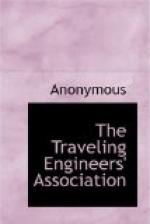A. Steam enters the throttle valve located in the highest part of the dome in order to get the driest steam, then passes through the standpipe and dry pipe out of the boiler to the steam pipe tee or nigger-head located in the front end, then through steam pipes to the steam chest. A steam valve in each steam chest distributes the steam so that it enters the cylinders at or just before the beginning of the stroke; pushing the piston to the end of its stroke; just before the piston reaches the end of the cylinder, the steam valve opens communication to the exhaust port through a cavity in its exhaust side, then through the exhaust pipes and tips up through the draft or petticoat pipe and stack to the atmosphere. When steam pushes the piston through the cylinder, its power is transmitted by the main rod to the main crank pin which causes the wheels to revolve, thus moving the engine and its train.
7. Q. Why is it important that there be no holes through the smoke-box door or front end and none in smoke-box seams or joints?
A. So as to maintain as good a vacuum as possible in the smoke-box and prevent small amounts of air coming in through leaks which tend to heat and warp the smoke-box and its door.
8. Q. How should the locomotive be started to avoid jerks, and what train and other signals should be looked out for at the time of starting?
A. Place the reverse lever in full gear, open the throttle valve gradually so as to start the train one car at a time and easily. Look for signals ahead to show that the track is clear and switch is in correct position, then look for signals from the rear end that the train is all coming.
9. Q. Will an engine equipped with superheat units move as quickly as a saturated steam locomotive when throttle valve is first opened?
A. No.
10. Q. Why?
A. Because steam must first pass through superheat units before it enters the steam pipes leading to steam chest.
11. Q. In placing engine on the turntable, at water or stand pipes, or at other similar places, what must be done?
A. Close throttle valve sooner so that the steam confined in superheat units, pipes and steam chests, will have passed out to the atmosphere.
12. Q. After a locomotive has been started, how can it be run most economically?
A. By regulating the supply of steam to the steam chest with the throttle and the point of cut-off with the reverse lever; so that no more steam be used than necessary to maintain the proper speed, whenever possible working the engine at short cut-off so as to use steam expansively.
13. Q. What is meant by working steam expansively?
A. Hooking the reverse lever up toward the center gives the valve a shorter travel and closes the live steam port when the piston has made only a part of its stroke. This cuts off the supply of live steam coming from the steam chest. The expansion of the steam already in the cylinder pushes the piston to the end of its stroke without the use of a full cylinder of live steam.




